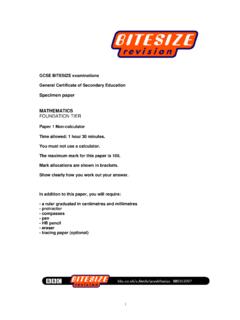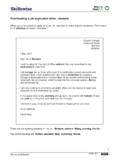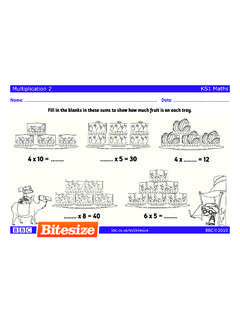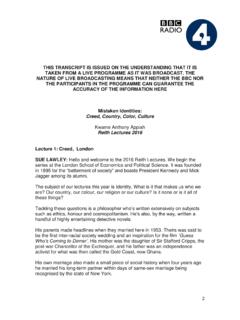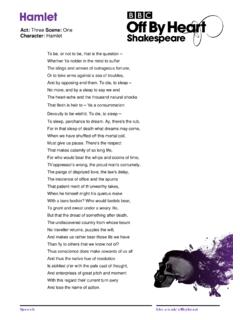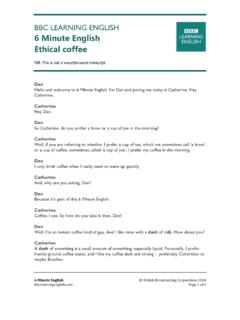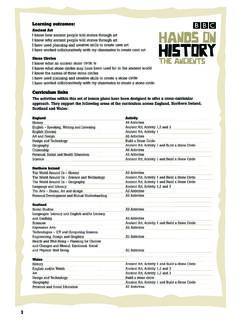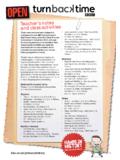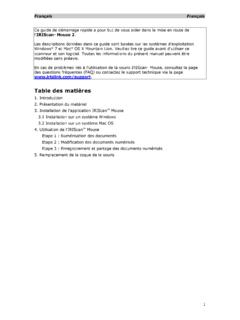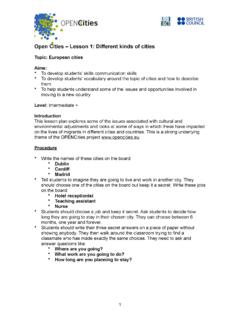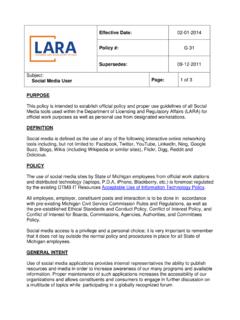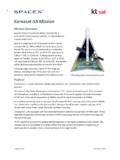Transcription of Find more Primary History resources at bbc.co.uk ...
1 1 For ideas about how touse these resources inthe classroom, refer tothe accompanyingTurn Back TimeTeacher s NotesFind more Primary History resources RecordshopBUTCHERest 1868 UNITEDDAIRY SHOPA ctivity 1 Types of shopCut out the shop signs and use them in a classroom activityabout high streets from the SHOP haberdashershaberdashersActivity 1 3 FISHMONGERSGREENGROCEREST 1906 Post OfficeActivity 1 4 New s AgentsGrocersGrocersNew s AgentsActivity 1 5 JewellersCHEMISTEST 1906llblacksmithestablished 1867 Activity 1 WordsearchHow many words can you find ? Cross them off the listas you uncover them. Be careful one doesn t appearin the puzzle, but which one could it be?GPLESMOQABDJTKEFWXGIRABFTIWLSRQEGMHNE RICOEMLAZSNILKJBQATPWOZCIOTEBAKERJSUDIAM FNEEZNYMUDEANTLUBREFOZARBEILZNMPAQWIVDXS YFGAXYVWORBCOUNTERECFNBZDAUQEMJSKTRLQEMA PMOBENSPLNRAJBICHSDLEGFKLVUWTSLEMXNYOSZE PRQEISHYZADJCBTCSERSQANIVJXKIRONMONGERLD PMOQERESDTCUFBRVAWZXGYHARGJXYSMSBJLDEFME HNZBYOEHFUZWXBNESAFRCDTZVIKJLAMEZPOQUHRM TNSRAFBUTCHERXMEZPOTWMOSNBVAMPZTONBFJKEP ADFMQAEBNDMSPWZIFXOQUCUIBVTLSNAQEBLACKSM ITHB utcherGrocer BakerIronmongerHairdresserBlacksmithReco rd shopSupermarketScalesDelivery vanSausagesSweetsMoneyEricCounterActivit y 1 7 Design your own shop advertThink about including: The name of your shop choose one you know or make up your own!
2 A picture of the shop or the items sold there this should make people want to buy things, so make it bright and colourful. The location of the shop so people know where to find 2 The shop front 8 Activity 3 Going letter to post - 1dThe Times Newspaper - 3dI pint of milk - 2d 1 Dozen eggs - 1 and d Your shopping list andwhat each item costs:A Shopping list from around 1900 The value of money: 240 pennies make up an old pound.(pennies were written as d) 12 pennies equal 1 shilling shown as 1sYou have to decide what you would buy to help your family eat a healthy diet. You have 3d to spend. Work out what you could a ord to buy. A Shopping list from around 1914 The value of money: 240 pennies make up an old pound.(pennies were written as d) 12 pennies equal 1 shilling shown as 1sYou have to decide what you would buy to help your family eat a healthy diet. You have 4d to spend. Work out what you could a ord to buy. Pint of Milk - 1d1/2 dozen medium sized eggs - 3d lb of loose tea - 2dLoaf of bread - 1d9 Historic Shopping lists 1900 to 1975 Split the class into groups or pairs and hand each a historical shoppinglist.
3 Each group needs to work out what they can a ord to 3 I PINT OF MILK - 2D1 TIN OF BEANS 7 DDOZEN EGGS 1S 6 DMARS BAR 6 DYour shopping list andwhat each item costs:A Shopping list from around 1940 The value of money: 240 pennies make up an old pound.(pennies were written as d) 12 pennies equal 1 shilling shown as 1sYou have to decide what you would buy to help your family eat a healthy diet. You have a shilling to spend. You must remember that everything is rationed due to World War Two and eggs and chocolate are very scare so these may only be available on the black market. Work out what you could afford to buy. A Shopping list from around 1950 The value of money: 240 pennies make up an old pound.(pennies were written as d) 12 pennies equal 1 shilling shown as 1sYou have to decide what you would buy to help your family eat a healthy diet. You have 1 shilling to spend. Work out what you could afford to buy. PPint of Milk 2dLoaf of bread 2d1/2 dozen Eggs 3dBag of sugar 5dYour shopping list andwhat each item costs:A Shopping list from around 1975 The value of money: In 1971 Britain moves to the decimalisation system and have the same system as today.
4 100 pennies = have to decide what you would buy to help your family eat a healthy diet. You have 1 to spend. Work out what you could afford to buy. 1 pint of milk 7pLoaf of bread 16p6 eggs 21p Cheese shopping list andwhat each item costs:10 Activity 4 The High In groups or pairs, ask your students to research one of the six time periods below featured in the BBC 1 series Turn Back Time. In particular, ask them to find old photographs or drawings of high streets from the time period. Victorian eraThe Victorian era saw the creation of the high street as we know it today. As more people moved into the cities, fewer were able to grow their own produce and began to rely on shops for food and other goods. Meat and vegetables were displayed for all to see outside the shops, so the early high street looked more like what we would now call a market. The buildings had small windows to help keep the contents cool and some would have had workrooms for making the products on sale.
5 Victorian photos are extremelyrare, but sketches and cartoons may be eraIn the Edwardian era shopping became a pastime in itself. Cheap imports meanteven the poorest people were able to afford meat on occasion and canned goodswere becoming more popular. Selfridges opened in 1909, bringing luxury to thepeople as never before. The start of the First World War in 1914 shattered the comforts of the early 1900s and food prices soared. Edwardian photos are blackand white or a brown, sepia colour. You can differentiate them from the 1930s images, as shops still tended to show their wares outside. 11 Activity 4 12 The 1930s During the 1930s shopowners began to use the power of advertising and window displays to draw in customers. Goods inside were displayed in glass cabinets andbrands we d recognise today appeared. Shops like Woolworths, Burtons and Bootsbegan to dominate the market. Food was becoming relatively cheap, with fruit andvegetables year-round staples and tinned foods growing in popularity.
6 Refrigeratorsbegan to make an appearance in some domestic kitchens, allowing people to storefood for longer and shop less frequently. This trend would become more pronouncedin later decades. Photos from the 1930s are black and white with advertising postersand branding appearing on walls and War TwoIn the Second World War, particularly once rationing began, shoppers would queue for hours outside shops if they heard food was available. Shop windows displayed posters about saving food, fuel and goods and, inside, many shelves were empty. People had to register with most shops to be able to buy goods, so shopkeepers became very important in the community. As imports fell, favouriteproducts became rare and buying new clothes became almost unheard of. Paper was scarce, so purchases were often taken home unwrapped. Photographs from this era are still black and white, though there may be some very early 1960s In the 1960s self service became the norm in most shops and mass-produced breadmeant many bakeries closed.
7 Shops became brighter and more colourful both insideand out, with neon, plastic and Formica appearing. This was particu larly noticeable inmilk and burger bars, some of which had jukeboxes. Fluorescent lights were introduced inmany stores, as well as the shopping trolley. Better food packaging, refrigeration and arise in car ownership led to the swift growth of supermarkets which changed shoppingpatterns from daily to weekly. Photos from the 1960s are often shinier (both black andwhite and colour) with white 1970sThe 1970s saw the establishment of the weekly shop in large supermarkets, as morewomen worked and shopping was done at the weekend. Shopping deliveries ceased,with newspapers and milk remaining the exceptions. Sell by dates began to appear on packaging and frozen food became much more prevalent. Corner shops could stayopen for longer hours than supermarkets, and often became the hub of a and betting shops, Chinese takeaways and boutiques became high street stalwarts.
8 Photos from the 1970s will still often be black and white (and may be a bit foggy ), so look out for clothing hints, like flared 4 13 Createa scrapbook or collageout of the photos youhave foundActivity 4 What am I looking for?You can find out about the History of the high street through: Old photos, paintings or drawings Old products, packaging and branding Newspaper cuttings Copies of local records (try your local library) Oral History talk to your parents, grandparents or guardians about what the high street was like when they were growing up. How old is my photo?Photographs are a great source of information. Answer the following questions to identify what time period your photo is from: Is it colour, black & white or sepia tones? If there are people in the photo, what are they wearing? If there are vehicles, what are they? Can you seea number plate to help you identify the year? Is there any street furniture? (Postboxes, street lamps, street signs, traffic lights etc) Are there any other clues?
9 Look at the skyline and trees and for landmarks you can date, for example war memorials or town fountains. If you found your photo on the internet, does the website tell you anymore information about it? If you are actually holding the old photo, what kind of paper is it printed on and are there any dates or notes on the back?You ll find some examples of old photos on the Turn Back Time Flickr group. 14 Colour in Eric visiting this oldfashioned grocery 4 Turn Back Time: Flickr groupWhat to do Choose a photo from your research that is over one year old. Take this photo out with you into the high street and find thespot from where the photo was taken. Hold the photo out at arm s length in front of you (or ask a friend to hold it for you). Use buildings and landmarks to line it up with the street as it looks today. Take a new photo to create a now and then image. Return home to upload it to our gallery or, if you need somehelp, visit your local rules are really simple: The only part of you (or a friend) that should be visible in the photo is a hand.
10 Photos must not be copyright in any way for example the photomust be your own or you must have permission to use it. Each photo must be uploaded by anadult and tagged with your locationso other people in your area can find it. Also include your favourite information from your research. You will find full terms and conditions along with clearinstructions for uploading yourphoto at: 4 To find details of family activitiesand events taking place acrossthe UK go to: In 1801, 20% of the population lived in towns and cities. By 1901 what percentage lived in towns and cities? Was it:A: 30% B: 50% C: 80%2. In January 2009, a well-known high street store closed all its shops, after nearly 100 years of trading in the UK. What was the name of the shop?A: Zavvi B: Woolworths C: MFI3. Which item in the following list was not rationed during World War Two?A: Petrol B: Fish C: Honey4. In 1943, how many allotments were there in Britain? Was it:A: 20,000 B: 800,000 C: 1,400,000?


